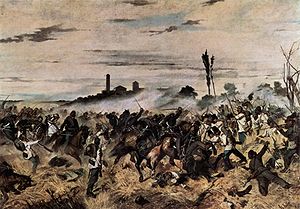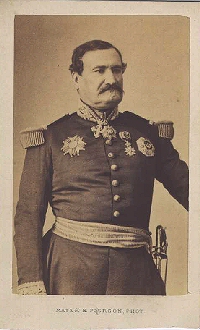Battle of Montebello (1859)
| date | May 20, 1859 |
|---|---|
| place | Montebello della Battaglia , Lombardy , Italy |
| output | Franco-Sardinian victory |
| Parties to the conflict | |
|---|---|
| Commander | |
| Troop strength | |
| about 7,000 men | about 25,000 men |
| losses | |
|
723 men dead and wounded |
1,377 men dead, wounded or captured |
The Battle of Montebello May 20, 1859 was the first engagement of the Sardinian War .
prehistory
The Savoy and Piedmontese had long formed an alliance with France in order to fight together against the Austrians in the Second War of Independence. Emperor Napoleon III. had arrived at his temporary headquarters in Alessandria on May 14, 1859 and took over the command . The Sardinian-French troops were not yet united, the emperor's army had around 70,000 French on the right bank of the Tanaro . In the first meeting the I. and II. Corps to Sale and Voghera and in the second meeting the III. Corps as reserve at Tortona . The second army (about 18,000 French and 50,000 Sardinians) on the left bank of the Tanaro had primarily concentrated the IV Corps and the Piedmontese army as the left wing between Valenza and Casale . According to plan, the Sardinian division Cialdini and the French III. and IV. Corps (under Canrobert and Niel) advance to Ticino, while the other army (4 Sardinian divisions and French I Corps) was to concentrate with the front to the north at Alessandria. Both armies were supposed to achieve unification before the objective of the operation, the conquest of Milan, was achieved. The rapid incursion of the Austrians into the province of Lomellina made this plan inoperative.
The Austrian Commander in Chief Feldzeugmeister Gyulay was mainly concerned about his left wing and that it would not be circumvented by crossing the allies over the Po below his position. In order to clear up the presumed action of the Allies against Piacenza and to counter this danger, the approximately 25,000 strong Austrian V Corps under FML Philipp von Stadion was advanced on May 20 via Stradella against Voghera . In the following battle in Montebello , the Austrians met the avant-garde of the Élie-Frédéric Forey division , which concentrated with around 9 battalions of infantry and 1 squadron of cavalry in and in front of Voghera.
The battle
At 5 a.m. the left column of Austrians under FML Baron von Urban first reached the enemy line, as the vanguard his brigade under General Schaffgotsche moved into the initial battle on the road from Broni to Casteggio , followed by General Braum's brigade as a second meeting. The middle column was formed by the division under FML von Paumgartten . The right column detached further down, the brigade of the Prince of Hesse, crossed the Po river at Vaccariza early in the morning and, marching on Branduzzo via Verrua, only reached Calcababbio in the afternoon . Around 11:00 am, Graf Stadion had sent the order to attack Casteggio, which was supported by the Gaal Brigade. General Forey put his division in defensive position east of the Staffora Bridge. The outposts of the French 84th Regiment had meanwhile been driven from a hamlet near Genestrello. East of Casteggio at the so-called St. Zeno-Graben, the road to the entrance to the town was barricaded by Italian insurgents , who gathered in the hundreds in Verzate, opened strong gunfire, while Piedmontese cavalry gathered on the same road. The Novara and Montferrat cavalry regiments under General Sonnaz had made a counterattack on the right of the road. The Graf Stadion, who arrived at Montebello around this time, saw that the attack on Genestrello had exceeded his predefined dispositions, the early attack by Baron Urban had thwarted the planned simultaneous attack by all three columns. The village of Genestrello became the base of the previous Austrian battle line, while initially the French-Sardinian troops had to retreat behind the Fossagasso stream. It was not until 3 p.m. that the brigade of the Prince of Hesse intervened north of the battle line at Casteggio-Montebello, where the general battle had been going on for a long time. As a result, a violent clash with the French developed on the railway embankment between Casteggio and Montebello.
Around 3 p.m. Forey decided to counterattack to save his positions. The hunters of General Beuret's brigade advanced on the right wing in the Echelon , on the left the Blanchard brigade managed to break through the embankment and occupy Caes. Nuova, after all Genestrello was wrested from the Austrians. The right wing of the front Austrian meeting backed away after being threatened by being surrounded. General Blanchard had meanwhile assigned three battalions of the 98th Line Regiment through the grain fields to the northern district of Montebello and was standing in front of the Schizzola, between the railway and the road crossing the town. There followed a fierce battle for ownership of the local churchyard, which the French won. Although the Bils Brigade arrived at Casteggio in the late afternoon, this Austrian reserve did not come into the meeting because Baron Stadion preferred, despite his numerical superiority, to break off the fight in order to allow his troops to withdraw in an orderly manner before dark.
consequences
The total loss of the Austrians in the battle was 1,377 men, the French lost 723 men, including General Beuret. This first victory contributed significantly to the self-confidence of the Italians and demoralized the Austrian troops. All over Italy volunteers volunteered for the War of Independence, the next great victory of the allies followed ten days later on the Sesia in the Battle of Palestro .
literature
- Johann Christoph Allmayer-Beck , Erich Lessing : The K. (below) K. Army. 1848-1914. Prisma, Gütersloh 1980, ISBN 3-570-07287-8 .



